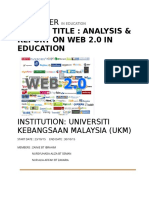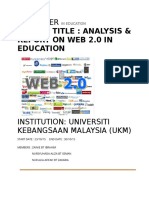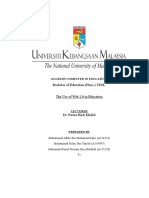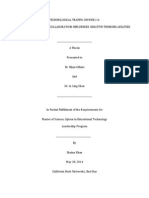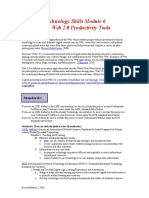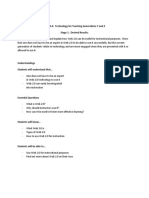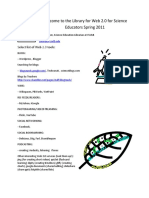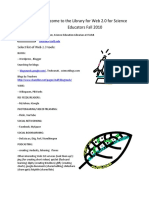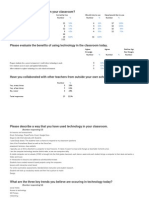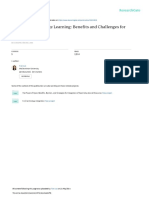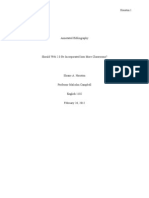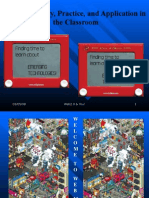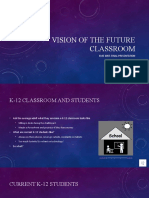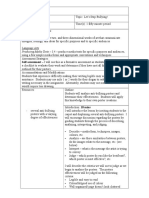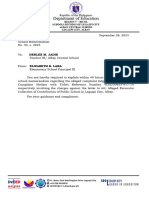GGGE1155
COMPUTERINEDUCATION
(GroupReport)
GroupMembers :
1. NurFatihahbintiAbdulRahman
A151131
2. A.S.NorFarahFadzilabintiIbrahim A151237
3. NurulAkmarbintiMohamadNoor
A150551
1.0Introduction
Studentlearningstylesarebeginningtochangewithincreasedaccesstomediaanddigital
devices(Dedeetal.,2007Restak,2003).Withtheevolutionofnewinteractiveandsocially
constructedWeb2.0toolsontheInternet,teachershaveaccesstoagreaternumberoffree
toolsforteachingandlearningsupport(Ajjan&Hartshorne,2008Anderson,2007
Maloney,2007OReilly,2005).Weoftenheardaboutusingandincludingtechnologyin
teachingandlearningprocess,thus,Web2.0inEducationisintroduced.UsingWeb2.0in
educationbasicallymeansusingtheWeb2.0toolssuchas,Blendspace,Voicethreadand
Polldaddyintheteachingandlearningprocess.Web2.0toolsrepresentonetoolusefulin
enhancinglearningaccessibilityandquality.
Inthisstudy,weanalyzedthecurrentuseandunderstandingofMalaysianstudentsinWeb
2.0.Aswearelivinginthe21stcentury,kidsnowadayspreferusingtechnologyinwhatever
theydo.Forexample,intheirlearningprocess.Lately,therearemoreschoolsthatinclude
technologyasapartoftheirlearningprocess.Wecanseethatstudentsaremoreinterestedin
theirstudieswhenevermediaisinvolved.IncludingWeb2.0inlearningisimportantto
increasestudentsinterestinstudying,tocreateonewhomfullyequippedwithknowledgein
termsofacademicandpracticalandproduceMalaysianswhoareversatile.
2.0LiteratureReview
AsecondgenerationoftheWorldWideWebthatisfocusedontheabilityforpeopleto
collaborateandshareinformationonline.Web2.0referstothetransitionfromstaticHTML
WebpagestoamoredynamicWebthatismoreorganizedandisbasedonservingWeb
applicationstousers.Itisalsorevolutionarynewwaysofcreating,collaborating,editingand
sharingusergeneratedcontentonline.
inserttheonefromslides
3.0ResearchObjectives
TodeterminehowdeepisthepeopleunderstandingtowardsWeb2.0inEducation
ToidentifywhatpeoplethinkabouthowfarWeb2.0contributeinMalaysiaeducation
ToidentifywhataretheiropinionsregardingWeb2.0inEducation.
4.0ResearchMethodology
Surveymethodologystudiesthesamplingofindividualunitsfromapopulationandthe
associatedsurveydatacollectiontechniques,suchasquestionnaireconstructionandmethods
forimprovingthenumberandaccuracyofresponsestosurveys.Pollsaboutpublicopinion,
publichealthsurveys,marketresearchsurveys,governmentsurveysandcensusesareall
examplesofquantitativeresearch.
Inthisresearch,weareusingquantitativeresearchandthemethodthatweusedisasurvey.
Wemakeaquestionnairethatconsistofeightquestionsanddistributedit.Wedistributedthe
questionnaireonlineusinggoogleform.Wedistributedtheonlinegoogleformtoour
classmatesandfellowfriends.Therespondentsneedtoanswerthequestiononline.We
gatheredourquestionnaireviagoogleformasgoogleformwillgiveusthenumberof
respondentsthathadansweredourquestionnaire.Googleformalsogivesusresultfromthe
answers.
Questions
Oursurveyformconsistsofeightquestionsthatthathasvarioustypethatarerangetype,yes
orno,multiplechoiceandopinionsquestions.
4.2Participants
Ourexpectationistogain80responsesbutweonlyreceived64responses.Ourrespondents
includemaleandfemalefromvariousuniversities.Wedidnotrestrictonlyrespondentsfrom
ouruniversityonlytheNationalUniversityofMalaysia,butalsotootheruniversitiesas
well.However,itfulfilltheregulationtoreceivearound30responses.Thereare58female
responseswhereasonly8maleresponses.
Next,theagerangeismajorityinthe18to20yearsoldwhichis73percent,whereasthere
arenoonefromtheagerange27yearsoldto29yearsold.Wethinkthatthisisbecausethe
youngeronesaremorelikelytospendmoretimeovertheInternet.
DataCollection
Forthisresearch,wehaveconductedasurveyonline,usingGoogleFormtocollectourdata.
UsingGoogleFormwillsaveupmuchofourtimebecausewedonothavetogooutand
meettherespondents,insteadweneedtojustpostthesurveyonsocialsites,andcollectthe
data.Wehavesuccessfullyreceived64respondentsfromdifferentbackground.
DataAnalysis
Basedontheresults,wecananalyseandsummarizetheresultintheformofpiecharts,graph
andalsopercentages.Wealsohavedonethecalculationsthatwehavegainfromthe
respondents.However,notallofourquestionscanbecalculatedthemean,onlyonequestion
whichistherangetypequestion.
Inthisprocessofanalysingthedata,wehavedividedtheworkintothreesincewehavethree
membersinagroup.Weusedchartsandgraphstomakesureouranalysisisaccurate.
Fromthissurvey,wearelookingforresponsesthatarecompatiblewithourobjectives.From
these,wewillhavetomakeaconclusionontheoverallsurvey.
Findings
Whatwearegoingtodiscussnowiswhatwegainedfromoursurvey.
Wehaveatotalofninequestions.Firstly,fromourfirstquestionthatask"Web2.0describes
WorldWideWebsitesthatusetechnologybeyondthestaticpagesofearlierWebsites"is
actuallyasimpledefinitionofWeb2.0.Weaskthistodeterminewhethertherespondents
knowaboutWeb2.0.Fromtheanswer,wecanseethatonly11percentofthemwhichis
about7outof64respondentsanswereditwrongly.itshowsthatalmosteveryoneknowsthe
basicinformationaboutWeb2.0.
Figure 1 above shows the responses for Q1
WealsoaskedthemabouthowdidtheydiscoveraboutWeb2.0.61percentofthemsaidthat
theyknowaboutWeb2.0fromtheirfriends,39percentfromthesearchenginesuchas
Google,Yahooandmanymore.31percentansweredthattheyknowfromschool.While27
percentoftherespondentsknowitfrommediasuchastelevision,radioandother.Lastbut
notleast,6percentansweredtheyknowaboutWeb2.0fromothers.
Figure 2 above shows the responses for Q2
Forquestionthree,thequestionis"HowoftendoyouuseWeb2.0inyourlearning
process?".Thisisarangetypequestionsandthereare64responses.Thehighestresponsesis
5percentandabovetimesperweekanswerasitis39percent.Itwasagreedby25percentof
therespondents.Meanwhile,thelowestresponsesare0,andthereisalso14percentandwas
answeredby4respondents.
Figure 3 above shows the responses for Q3
Figure 4 above shows the responses for Q4
Question4is"HowfardoyouthinkWeb2.0contributeinMalaysianEducation?".Thisis
alsoarangetypequestions.Thehighestanswersarebetween3and5asthenumberofthe
respondentsarethesamewhichis22andthepercentagesare34percent.Thelowestanswer
is2percentasonlyonerespondentchoseit.
Figure 5 above shows the responses for Q5
Ourfifthquestionisthat,weaskedtherespondentstoticktheexamplesofWeb2.0tools
theyhaveused.OutoftenchoicesthatwegivethemSlideshare,Wallwisher,Weebly,
Wikipedia,Prezi,Bubbl.us,Flickr,Mindomo,Project.me,GoogleDocs,thehighestWeb2.0
toolsthattherespondentshaveexperienceinusingitis,GoogleDocs,whichiswith77
percent,followedbySlidesharewhichis73percent.WikipediaisalsothemostusedWeb2.0
toolsamongtherespondentswhichis66percent.52percentofrespondentshavechosen
Weebly,meanwhile,45percentofthemhaveusedPrezi.Otherthanthat,27percentofthe
respondentshavepickedFlickrasoneoftheWeb2.0toolsthattheyfamiliarwith.Besides,
Present.meisthesecondlowestWeb2.0toolsthattherespondentshaveused,withonly20
percent,followedbythethelowestWeb2.0toolswhichareBubbl.usandWallwisher.
Figure 6 above shows the responses for Q6
MovingontothenextquestionisaboutdotheythinkWeb2.0isconvenientindailylearning
process.Thisisoneofthequestionthatispreparedbyus,aimedtofindouthowmuchWeb
2.0helpsindailyteachingandlearningprocess.Wehaveanalysedtheresultintermsofpie
chartbecauseitisasimpleYesandNoquestion.Overall,majorityoftherespondentsagreed
thatWeb2.0isindeedconvenientindailylearningprocess,with94percent,andfollowedby
6percentofthemdisagreethatusingWeb2.0inlearningprocessisconvenient.
Moreover,wealsoincludedaquestionabouthavetheyrecommendedWeb2.0toanyone.72
percentoftherespondentshaverecommendedusingWeb2.0totheirpeersorjustanyone.
Meanwhile,therestofthem28percentofthemhaveneverrecommendedusingWeb2.0to
anyone.
Movingontothelastquestionofoursurvey.Weaskthemabouttheiropinionsabouthowto
improvetheusageofWeb2.0ineducation.Wemadethisquestionnotcompulsoryto
answer,sowereceived26responsesoutof64.Herearesomeoftheanswersthatthe
respondentsgave.
1. NeedtoprovidemoregoodInternetconnectionsothatthesekindsofeducationcould
bewellmanagedeverytimeneeded.
2. Theusageneedtobeimprovisetoschoolstudents.
3. Flippedlearningisthebestwaytointroduceweb2.0tostudentsastheyhaveto
exploremanythingsbythemselves.Lecturerscangivetheassignmentsbyusing
differentkindsofweb2.0.
4. AlwaystakemoreinitiavetoimprovetheWeb2.0inEducation.
5. Good,mostlyforstudents
6. Goodforlearningprocessandshouldbepromotedworldwide
7. Giveextrasecurity.
8. TheWeb2.0shouldimprovemuchfasterandwiderrangeofinformationcanbe
sharedinsteadofjustonespecificstuff.
9. Canalsobeusedinclass,forteachers
10. UpgradetheapplicationsinsidetheWeb2.0
11. CreateorbuyagadgetthatsupportstheWeb2.0.
12. TeachersshoulduseWeb2.0appsmoreofteninlearningprocessandintroducetothe
studentsaboutthebenefits.
13. EducatorsneedtostarttouseWeb2.0inearlystagestoexposedthechildrensothat
theyhavevarietieswaysoflearning,thuseveryschoolshouldprovidetheproper
toolssothatthisaimwillbeachieved.
14. Shownewkindsofnewguide.
15. Tryinganerrorexperimenting
TherearethreerespondentswhoalsosaidnoneedimprovementonthecurrentuseofWeb
2.0becauseitisactuallydependsonthestudentstostartdoingit,withouthavingtheteachers
tointroducetothem.
Discussions
Fromtheresponsesthatwehavegained,wecansaythatpeoplethinkdifferently.Now,the
discussionbelowwillbrieflytellaboutwhywethinkthatsuchresponsesarereceived.
Forthefirstquestion,mostoftherespondentsknowthetruemeaningofWeb2.0probably
becausetheyhaveencountereditsomewhere.Inouropinion,theteachersinschoolhave
introducedaboutWeb2.0inschool.
Besides,thesecondquestiontellsushowtherespondentsdiscoveredaboutWeb2.0andmost
ofthemfoundoutfromfriendsorcolleagues.Webelievethatthisisbecause,therespondents
spentmoretimewiththeirfriendsmorethananythingandanyone.Surprisingly,thelowestis
frommedia,whereaswethoughttheywilllearnmorefrommediaandInternetsites.
Ontheotherhand,thenextquestionisaboutthefrequencyonhowmuchtheyuseWeb2.0
perweekandwefoundthatmajorityofthemusesitquitefrequentlywhichis5timesper
week.Thisisprobablybecausetheyspentmoretimeonthelaptopandgoingoverthe
Internet.Eventually,theywillgetexposedtoitbitbybit.
Moreover,thefourthquestionarangeofhowmuchtheythinkWeb2.0contributesin
MalaysiaEducation.Mostofthemgavearateof5,andinourownopinion,wethinkthatthis
methodhasbeenintroducedtothemsincetheywereinsecondaryschool.Theyprobably
haveseenthegoodresultintheirexamination,andusingWeb2.0probablyhashelpedthem
alot.
Forquestions5,mostoftherespondentsknowoftheexamplesofWeb2.0applicationsthat
werelisted.Maybe,itisbecauseoftheusageofthoseapplicationsintheireducation.
Questions6statedabouttheconvenientofWeb2.0indailylearningprocessasmanyagreed
toit.Itisbecausetheycanlearnsomethingnewwiththoseapplicationsthatwereabletohelp
themintheirwork.
Itseemsthat,almostmostofthemhaverecommendedWeb2.0towardseveryonebecauseof
theirfamiliarityoftheapplications.ItisalsobecausethatWeb2.0canhelpthemdoingtheir
work.
ManyoftheopinionsregardingonhowtoimprovetheusageofWeb2.0ineducationare
that,theuseofWeb2.0shouldbeinstillinthelearningandteachingclasses.Itisprobably
becauseofthegoodresultsonusingtheapplicantsofWeb2.0thatboostuptheir
performance.
Conclusion
Toconclude,wefoundoutthatWeb2.0iswidelyknownandusefultoallkindofstudents
nomatterinprimary,secondaryschooloruniversitystudents.MalaysiaEducationis
instillingtheproperuseofWeb2.0fortheeducationpurposes.ImprovingtheusageofWeb
2.0ineducationwillresultsinproducingexcellentstudents.
References
MartynShuttleworth.2009.WritingMethodology(atastalian)
https://explorable.com/writingmethodology
MichelleRogersEstable.2014.Web2.0UseinHigherEducation.EuropeanJournalof
Open,DistanceandeLearning17(2)(atastalian)
http://www.eurodl.org/materials/contrib/2014/RogersEstable.pdf
